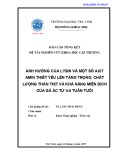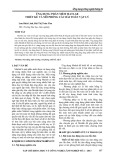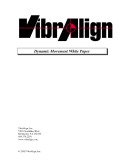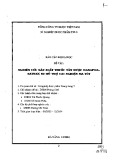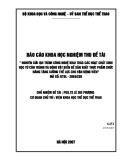
BioMed Central
Page 1 of 9
(page number not for citation purposes)
Genetics Selection Evolution
Open Access
Research
Model for fitting longitudinal traits subject to threshold response
applied to genetic evaluation for heat tolerance
Juan Pablo Sánchez*1, Romdhane Rekaya2 and Ignacy Misztal2
Address: 1Departamento de Producción Animal, Facultad de Veterinaria, Universidad de León, Campus de Vegazana, León, 24071, Spain and
2Animal and Dairy Science Department, University of Georgia, 425 River Road, Athens, GA, 30602, USA
Email: Juan Pablo Sánchez* - jpsans@unileon.es; Romdhane Rekaya - rrekaya@uga.edu; Ignacy Misztal - ignacy@uga.edu
* Corresponding author
Abstract
A semi-parametric non-linear longitudinal hierarchical model is presented. The model assumes that
individual variation exists both in the degree of the linear change of performance (slope) beyond a
particular threshold of the independent variable scale and in the magnitude of the threshold itself;
these individual variations are attributed to genetic and environmental components. During
implementation via a Bayesian MCMC approach, threshold levels were sampled using a Metropolis
step because their fully conditional posterior distributions do not have a closed form. The model
was tested by simulation following designs similar to previous studies on genetics of heat stress.
Posterior means of parameters of interest, under all simulation scenarios, were close to their true
values with the latter always being included in the uncertain regions, indicating an absence of bias.
The proposed models provide flexible tools for studying genotype by environmental interaction as
well as for fitting other longitudinal traits subject to abrupt changes in the performance at particular
points on the independent variable scale.
Introduction
Reaction norm models have been proposed as an alterna-
tive for fitting Genotype by Environment interactions
(GxE) in evolutionary biology and animal breeding [1]. In
reaction norm models, the environment is often
described by a continuous variable, and the phenotypes
are partially explained by the regression of the genotypic
values on the environmental values. When an environ-
mental variable is observed on a continuous scale (i.e.,
temperature), it is expected to have a direct one-to-one
relationship between the environmental scale and values.
Consequently, the reaction norm model can be fitted by
regressing the genotypic values on the observed environ-
mental scale [2,3]. When the observed environmental
scale is not continuous (i.e., herd classes), the genotypic
values can be regressed on the effect of the categorical var-
iable defining the different environments using, for exam-
ple, least squared means of the class effects [4] or inferring
the environmental values jointly with the remaining set of
parameters in the model [5].
In animal breeding applications of reaction norm models,
it was assumed that both the mean and the variances are
either continuous, monotone functions of the environ-
mental values [4,6] or that they are such only when the
environmental values exceed a certain threshold [2,7,3].
In past studies involving thresholds, the same threshold
was assumed for all animals, and it was estimated based
on the quality of the fit of the average performances as a
function of environmental values.
Published: 14 January 2009
Genetics Selection Evolution 2009, 41:10 doi:10.1186/1297-9686-41-10
Received: 17 December 2008
Accepted: 14 January 2009
This article is available from: http://www.gsejournal.org/content/41/1/10
© 2009 Sánchez et al; licensee BioMed Central Ltd.
This is an Open Access article distributed under the terms of the Creative Commons Attribution License (http://creativecommons.org/licenses/by/2.0),
which permits unrestricted use, distribution, and reproduction in any medium, provided the original work is properly cited.

Genetics Selection Evolution 2009, 41:10 http://www.gsejournal.org/content/41/1/10
Page 2 of 9
(page number not for citation purposes)
The objective of this study was to present a Bayesian hier-
archical model for fitting a longitudinal trait showing an
abrupt linear change at some value of the independent
variable. Simulations were inspired by reaction norm
models, and the procedure postulates that the effect of the
environmental variable is not existent until it exceeds a
certain unknown value particular for each individual with
data. Furthermore, the model allows for partitioning indi-
vidual variability on the threshold into genetic and envi-
ronmental components.
Methods
Model and Prior specification
A general description of hierarchical Bayesian modelling
can be found in [8]. Here the first stage of the hierarchy
describes the data generating process, or the conditional
distribution of the observed phenotypes given the model
parameters. The following model was assumed:
yijk = CGk +
j +
j × max{0, THIij -
0, j} +
ijk,
where yijk is the ith observation measured on animal j in
contemporary group k (CGk), and THIij is the temperature
and humidity index [2,7] associated with the ith observa-
tion of animal j. Random variables
j,
j and
0, j associ-
ated with the animal j represent an intercept (
j), or
individual value in the absence of heat stress, slope (
j),
or a change in the performance per unit of change in the
THI index above the individual threshold (
0, j). In this
study, the heat load function [7] was defined in a way that
was similar to previous studies on genetics of instantane-
ous heat stress on daily milk production [2]. Finally,
ijk is
a random homoskedastic error term associated with each
particular observation.
The data was assumed to be normally distributed as fol-
lows:
The second stage of the hierarchy consisted of specifying
prior distributions for all parameters in the first stage.
where U indicates the uniform distribution and K is the
number of levels of the contemporary group effect.
The underlying variables associated with the jth animal,
j,
j and
0, j, were assumed to follow the multivariate nor-
mal distribution:
where , , and
,
0
and
0 are vectors including scalar parameters of individu-
als (
j,
j and
0, j).
Parameters of a given individual were considered to be
conditionally independent and affected at their mean
level by systematic (
,
and ) and genetic effects
(a
, a
and ); the residual (co)variance matrix between
underlying variables was R0, which is equivalent to a
(co)variance matrix between permanent environmental
effects on the observed measures scale.
In a third hierarchical stage, prior distributions for system-
atic and genetic effects and the residual (co)variance
matrix between underlying variables were defined. Sys-
tematic effects were considered to be uniformly distrib-
uted, and genetic effects were assumed to follow a
multivariate normal distribution according to the genetic
infinitesimal model [9]:
where G0 is the (co)variance matrix between the additive
genetic effects for the underlying variables. The residual
(co)variance matrix was assumed to follow a uniform dis-
tribution.
In the fourth and last hierarchical stage, a prior distribu-
tion was assigned to the genetic (co)variance matrix for
the underlying variables. A uniform distribution was
assumed as in the case of the residual (co)variance matrix.
Fully conditional posterior distributions
The fully conditional posterior distributions must be
obtained in order to perform a Bayesian MCMC estima-
tion procedure using the Gibbs sampler algorithm. After
defining the joint posterior distribution as the product of
the conditional likelihood and all the prior distributions
[8], the terms involving the parameter of interest in the
joint posterior distribution were retained. For the model
described, all the fully conditional posterior distributions
are exactly the same as those described for a hierarchical
model assuming intercept and linear terms [10], except
those involving the individual thresholds. For all the posi-
tion parameters, both in the first and second hierarchical
stages, the fully conditional posterior densities were pro-
portional to normal distributions; the fully conditional
y CG THI N CG THI
ijk k j j j ij k j j ij j
|,,,, ,~ max,
,,
020
0++× −
{}
,,.
2
()
20~,U+∞
()
CG ~,U
k
K
−∞ +∞
()
=
∏
1
,, | , , , , , , ~ , ,
000
00
aaa R X ZaI R
()
+⊗
()
MVN
(1)
′=′′′
()
,,
0
′=′′′
()
aaaa
,,
0
0
a
0
aaa G 0A G
,, | ~ , ,
000
()
⊗
()
MVN

Genetics Selection Evolution 2009, 41:10 http://www.gsejournal.org/content/41/1/10
Page 3 of 9
(page number not for citation purposes)
distribution for the residual variance in the first stage fol-
lowed a scaled inverted chi squared distribution, and the
genetic and residual (co)variance matrices in the third and
second stages followed inverted Wishard distributions.
For the thresholds, the fully conditional posterior distri-
bution had the following form:
which can be explicitly expressed as:
The first term comes from the likelihood; J refers to the
subset of records belonging to animal j. The second term
comes from the prior (second hierarchical stage); note
that the relationship between the animal j and the other
individuals in the population are taken into account
throughout the given values of the additive genetic effects.
In this second factor, scalars ri, j refer to the relevant ele-
ments of the inverse of R0, which is the residual (co)vari-
ance matrix in the second hierarchical stage. This fully
conditional posterior distribution does not have a known
closed form; thus a Metropolis step [11] was used to sam-
ple from it.
In the model presented, the definitions of the genetic and
phenotypic variances in a given environment are slightly
more difficult than in the standard reaction norm models
because a non-linear function of random correlated varia-
bles is involved. Thus, a Monte Carlo approximation of
the phenotypic variance was determined for a particular
value of THI during the measurement day. For example, in
a particular environment (THI value) this quantity was
calculated in the rth round of the Gibbs sampler:
where n is the number of records, and , with expected
value , is a vector of size n with typical elements
defined as below:
In this expression and are the sampled val-
ues for the additive genetic effects for the animal j during
the rth iteration; and are random deviates
sampled from , where is the value of
the residual (co)variance matrix in the second hierarchical
stage sampled; and are sampled values of the
overall mean for the threshold level and slope. They were
computed during the rth iteration by applying the appro-
priate vectors of linear contrast to the sampled vector of
systematic effects, and . Finally, in the equation
of the overall phenotypic variance, is the value of
the residual variance in the first hierarchical stage. We
used the aggregated phenotypes (i.e.)
instead of the sampled values , and to
avoid the variation due to systematic effects in the second
hierarchical stage.
For the case of the additive variance, its Monte Carlo
approximation can be computed by calculating this quan-
tity in each round of the Gibbs Sampler:
where N is the number of animals in the pedigree; A-1 is
the inverse of the additive relationship matrix; is a
vector of overall additive genetic effects sampled during
the iteration r; and is the expected value of the
random variable . The jth element of the vector
was computed in each round of the Gibbs sampler using
this expression:
where and have the same mean-
ing as those previously described in the equation for .
Note that non-zero expected values are considered in the
paaap
jjj jjj jj
0200
0
,,,,,
|, ,,, ,, , , , | , ,,yCG R y CG
()
∝
j
jjj j j j
paaa
,
|,,, , , , ,
,,,,
2
00
0
()
×
()
R
paaa
yijk CGk
jjj jjj
020
0
,,,,
|, , , , ,, , , ,
exp
yCG R
()
∝
−−−
jjj THIij j
jij
iJ
−× −
{}
()
⎧
⎨
⎪
⎩
⎪
⎫
⎬
⎪
⎭
⎪×
−
−
∈
∑
max , ,
exp
,
00
22
0
2
X
00
00
0
+
()
−−−
()
+− −
()
()
aj
jij ajrjij ajr
r
,
,,,,
XX
,,
,
0
2
2
00
⎛
⎝
⎜
⎜
⎜
⎞
⎠
⎟
⎟
⎟
⎛
⎝
⎜
⎜
⎜
⎜
⎞
⎠
⎟
⎟
⎟
⎟
⎧
⎨
⎪
⎪
⎪
⎪
⎪
⎩
⎪
⎪
⎪
⎪
⎪
⎫
⎬
⎪
⎪
⎪
⎪
⎪
⎭
⎪
⎪
⎪
r
⎪⎪
⎪
,
ˆ
ˆˆ ˆˆ
P
r
rErr
Er
n
2
[]
=
[]
−
[]
⎛
⎝
⎜⎞
⎠
⎟
⎛
⎝
⎜⎞
⎠
⎟′
[]
−
[]
⎛
⎝
⎜⎞
⎠
⎟
⎛
⎝
⎜⎞
⎠
⎟
pp pp
−− +
[]
1
2
ˆ
r
ˆ
pr
[]
Er
ˆ
p
[]
()
ˆˆˆˆmax ,
,,,,
pae ae THI
ij
r
j
r
j
r
j
r
jh
[] [] [] []
=+
()
+++
()
×−
0ˆˆ ˆ.
,,
0
00
r
i
r
j
ae
[] []
++
()
{}
ˆ,ˆ
,,
aa
j
r
j
r
[] []
ˆ,
aj
r
0
[]
ee
ii
,,
,
ei
0,
MVN r
0R,0
[]
()
ˆ
R0
r
[]
ˆ
0
r
[]
ˆ
r
[]
ˆ
0
r
[]
ˆ
r
[]
ˆ
2r
[]
ˆˆ,,
r
j
r
j
ae
[] []
++
j
r
j
r
[] []
,
0,j
r
[]
ˆ
ˆˆ ˆˆ
a
r
rErr
Er
2
1
[]
=
[]
−
[]
⎛
⎝
⎜⎞
⎠
⎟
⎛
⎝
⎜⎞
⎠
⎟′−
[]
−
[]
⎛
⎝
⎜⎞
⎠
⎟
⎛
⎝
⎜⎞
uuAuu
⎠⎠
⎟
−N1
ˆ
ur
[]
Er
ˆ
u
[]
()
ˆ
ur
ˆ
ur
[]
ˆˆ ˆˆmax , ˆˆ
,, ,
ua a THI a
j
r
j
rr
j
r
h
r
j
r
[] [] [] [] [] [
=+ +
()
×−+
0
0
0
]]
()
{}
ˆ,ˆ,ˆ,ˆ
,,
0
rr
i
r
i
r
aa
[] [] [] []
ˆ,
ai
r
0
[]
ˆ
pij
r
[]

Genetics Selection Evolution 2009, 41:10 http://www.gsejournal.org/content/41/1/10
Page 4 of 9
(page number not for citation purposes)
equations for computing both phenotypic and genetic
variances; the derived random variables, and ,
are non-linear functions of random correlated variables,
thus their expected values are non-zero [12]. Also note
that the relationships between records were not consid-
ered when computing the phenotypic variance due to
complexity.
Based on these computed variance components, relevant
genetic parameters and other genetic quantities can be
easily defined for different environments (THI values).
For example, heritability or expected genetic response to a
selection index could be defined for different environ-
mental values [13].
Data
Simulated data sets were used to investigate the perform-
ance of the Bayesian implementation of the model
described above.
Different combinations of heritabilities and correlations
for the underlying variables were investigated: low (0.1),
medium (0.2) and high (0.5) heritabilities; and low (0.2,
0.3) and high (0.7, 0.9) correlations, in absolute value. In
addition, two different data set designs were considered,
approximately 20 (S20) and 10 (S10) records per animal.
Thus, 12 different scenarios were investigated, and for
each one ten replications were run.
For both data size scenarios the same genetic structure was
considered but with different sizes. For S20 in the first
generation, 40 males and 200 females were generated,
and in the second generation, each sire was mated to five
females, producing four full sibs from each mating. Thus,
the entire population consisted of 1,040 animals. For S10
in the first generation, 80 males and 400 females were
generated, and in the second generation, each sire was
again mated to five females, producing four full sibs. In
this case the entire population consisted of 2080 animals.
This genetic structure resembles prolific species popula-
tions like swine or rabbit.
For both data structures 21,500 records were generated
according to the described model and assigned to the total
number of animals in the population. For generating
records only an overall mean (with a value of 90) was con-
sidered in the first hierarchical stage as the CG effect, and
overall means for the threshold (19) and for the slope (-
0.5) were the only considered systematic effects in the sec-
ond hierarchical stage. THI values were generated by sam-
pling from a Normal distribution with mean 18.0 and
variance 10.0, resembling the distribution of THI values
in a temperate climate.
Gibbs Sampler implementation
For each replication, a Gibbs Sampler algorithm was run
for 100,000 rounds, of which the first 10,000 were dis-
carded as burn-in period; afterwards one tenth of the
rounds were retained. The threshold level was sampled via
a Metropolis step by using a proposal density that was
normally distributed and centered on the previous value
of the threshold. The variance of the proposal density was
constant across animals. During the burn-in period, the
value of the variance of the proposal was tuned for an
average acceptance rate of around 0.5 under all the scenar-
ios. In a post-Gibbs analysis, the convergence of the
chains were assessed both by visual inspection of the trace
plots for the most relevant parameters and through the
Geweke test [14], in addition the effective sample size
(ESS) was computed using the function effective Size ()
from the coda package in R [15].
Results
Tables 1 and 2 show the results of the simulation averaged
over 10 replications for the 12 investigated scenarios. For
all the parameters and models, the true values were well
within the uncertain regions, which is an empirical indi-
cation of the unbiasedness of the inferential method. In
addition the means for all the parameters were very close
to their respective true values.
As expected, inference efficiency, measured through the
marginal posterior standard deviation averages across
parameters in Tables 1 and 2 (except residual variance),
was reduced as the correlations between underlying varia-
bles was reduced. On the contrary, algorithm efficiency,
measured through the ESS averages across parameters in
Tables 1 and 2 (except residual variance), decreased as cor-
relations increased. In both correlation scenarios, increas-
ing heritability increases inference efficiency for genetic
correlations but reduces efficiency for the estimation of
heritabilities and environmental correlations. In general,
the algorithm average efficiency increases with heritability
but some exceptions can be found, particularly under data
structure S10.
Figure 1 shows the marginal posterior distributions and
trace plots for the overall mean of the threshold level
obtained in one replication in the scenarios of high corre-
lation and low, medium and high heritabilities when the
data structure was S10. The reduction in quality of the
chain as heritability decreases can be observed in Tables 1
and 2.
Patterns of heritability with change in the THI during the
measure day are shown in Figure 2; these plots are esti-
mated from one replication in the scenarios of high corre-
lations and all the cases of heritability with the S10 data
structure. Relatively flat patterns were observed, and the
ˆ
ur
[]
ˆ
pr
[]

Genetics Selection Evolution 2009, 41:10 http://www.gsejournal.org/content/41/1/10
Page 5 of 9
(page number not for citation purposes)
95%HPD region always well covering the true pattern,
computed using the approximate formulas as previously
described.
Table 3 shows averages across replications of Pearson cor-
relations between predicted and true breeding values for
the underlying variables for the 12 investigated scenarios.
The predictors were assumed to be the average of the mar-
ginal posterior distributions. The observed values of these
correlations, i.e. accuracies, correspond well with the her-
itabilities and correlations used during the simulation.
Table 4 shows averages across replications of Pearson cor-
relations between true and predicted values for the under-
lying random variables defining the model in the first
stage of hierarchy, under the 12 investigated scenarios.
Discussion
The model presented in this study provides greater flexi-
bility over traditional reaction norm models when the
environmental variable is known, as it allows a semi-par-
ametric form for the reaction norm function. This is a
semi-parametric model in the sense that the point in
which the linear change is assumed to start is defined by
the data themselves. The forms of the functions before
and after this point are defined parametrically a priori, i.e.,
constant before the change point and a linear function
afterwards. To increase flexibility, higher order polynomi-
als or spline functions could be fitted within each one of
these two separate periods, with the advantage that within
each one of the periods, the functions would remain lin-
ear on the parameters. The presented inferential proce-
dure gave unbiased estimates because the uncertain
regions always covered the true value of the parameters.
Several alternative algorithms have been proposed for
non-parametric or semi-parametric curve fitting. One of
them is a Reversible Jump MCMC algorithm where the
optimal number of change points (parameters in the
model) is estimated [16]. The model presented in this
study is a simplified version of this semi-parametric pro-
cedure, as the number of parameters is fixed a priori. How-
ever, the indicated study focuses on fitting averages along
the independent variable trajectory; in our case we fit indi-
vidual sources of variation throughout this trajectory. For
this purpose and from a computational point of view, the
Table 1: Parameter estimates for 6 parameter scenarios when 20 records were considered per animal (averages over 10 replications)
123
True PMaPSDbESScTrue PM PSD ESS True PM PSD ESS
T19 18.96 0.15 352 19 19.10 0.16 416 19 19.08 0.16 399
h2I0.5 0.52 0.06 2110 0.2 0.20 0.05 583 0.1 0.14 0.05 318
h2S0.5 0.56 0.08 617 0.2 0.23 0.07 392 0.1 0.12 0.06 112
h2T0.5 0.48 0.18 91 0.2 0.36 0.15 98 0.1 0.37 0.16 95
g, I-S 0.3 0.26 0.11 818 0.3 0.30 0.23 301 0.3 0.54 0.27 75
g, I-T -0.2 -0.21 0.24 159 -0.2 -0.23 0.36 63 -0.2 -0.06 0.36 61
g, S-T -0.2 -0.31 0.23 141 -0.2 -0.19 0.33 99 -0.2 0.02 0.39 83
p, I-S 0.3 0.35 0.09 768 0.3 0.31 0.06 601 0.3 0.30 0.05 507
p, I-T -0.2 -0.23 0.23 129 -0.2 -0.22 0.16 209 -0.2 -0.29 0.14 217
p, S-T -0.2 -0.15 0.23 109 -0.2 -0.21 0.14 214 -0.2 -0.25 0.12 203
2e10 9.97 0.10 8142 10 9.98 0.10 9000 10 9.99 0.10 9000
456
True PM PSD ESS True PM PSD ESS True PM PSD ESS
T19 18.93 0.15 79 19 18.98 0.17 50 19 19.07 0.15 38
h2I0.5 0.50 0.06 1411 0.2 0.20 0.05 489 0.1 0.11 0.04 177
h2S0.5 0.52 0.07 433 0.2 0.22 0.06 297 0.1 0.15 0.06 110
h2T0.5 0.47 0.11 61 0.2 0.33 0.12 48 0.1 0.31 0.10 55
g, I-S 0.7 0.68 0.07 330 0.7 0.68 0.16 103 0.7 0.67 0.21 76
g, I-T -0.7 -0.68 0.12 51 -0.7 -0.56 0.24 29 -0.7 -0.44 0.31 33
g, S-T -0.9 -0.88 0.06 48 -0.9 -0.72 0.15 61 -0.9 -0.72 0.18 54
p, I-S 0.7 0.74 0.05 245 0.7 0.69 0.04 218 0.7 0.72 0.03 212
p, I-T -0.7 -0.64 0.13 48 -0.7 -0.72 0.09 39 -0.7 -0.79 0.08 30
p, S-T -0.9 -0.87 0.07 65 -0.9 -0.92 0.05 57 -0.9 -0.92 0.04 59
2e10 9.99 0.10 4018 10 9.97 0.10 5860 10 9.95 0.10 6458
a Marginal Posterior Mean, b Marginal Posterior standard deviation, c Effective sample size

